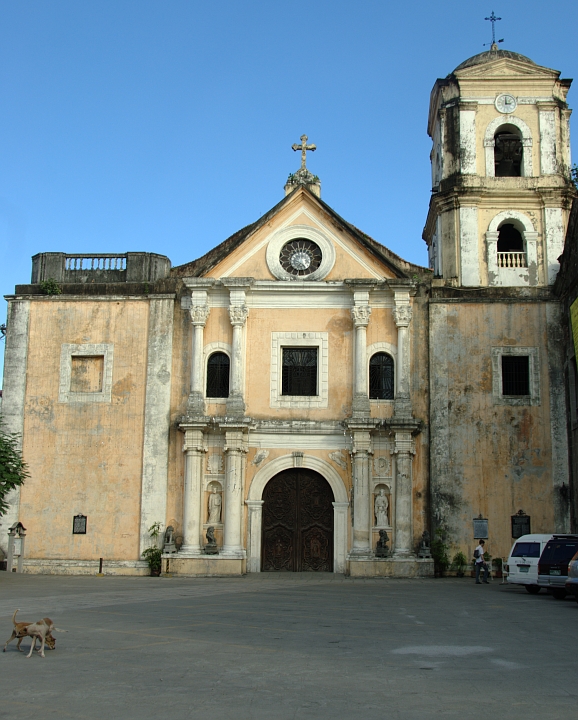- San Agustin Church, Manila
Infobox religious building
building_name =San Agustin Church
infobox_width =

image_size =220px
caption =
map_type =
map_size =
map_caption =
location =Intramuros ,Manila ,Philippines
geo =coord|14|35|20|N|120|58|29|E|display=inline|region:PH-00_type:landmark_source:dewiki
religious_affiliation =Roman Catholic
rite =
province =
district =
consecration_year =1607
status =church
functional_status =active
heritage_designation =
leadership =
architecture =yes
architect =Juan Macias
architecture_type =Church
architecture_style =baroque
groundbreaking =1586
year_completed =1607
specifications =yes
capacity =
length =m to ft in|67.15
width =m to ft in|24.93
materials =adobe stones
nrhp =
added =
refnum =
designated =San Agustín Church is a
Roman Catholic church under the auspices of The Order of St. Augustine, located inside the historic walled city of Intramuros inManila . Completed by 1607,Aluit, p. 41] it is the oldest church currently standing in thePhilippines . No other surviving building in the Philippines has been claimed to pre-date San Agustin Church.In 1993, San Agustin Church was one of four Philippine churches constructed during during the Spanish colonial period designated by the
UNESCO as aWorld Heritage Site , under the classification "Baroque Churches of the Philippines ". It had been named a National Historical Landmark by the Philippine government in 1976.History
The present structure is actually the third Augustinian church erected on the site.Layug, p. 83] The first San Agustin Church was the first religious structure constructed by the
Spaniards on the island ofLuzon .cite web |title=San Agustin Church (Intramuros, Manila) |url=http://heritageconservation.wordpress.com/2006/07/29/san-agustin-church-intramuros-manila |author=Heritage Conservation Society |accessdate=2008-03-24 ] Made ofbamboo and nipa, it was completed in 1571, but destroyed by fire in December, 1574 during the attempted invasion of Manila by the forces ofLimahong .Aluit, p. 40] Torres, p. 62] A second church made of wood was constructed on the site. This was destroyed in February, 1583, in a fire that started when a candle set ablaze the drapes of the funeral bier during the interment of the Spanish Governor-General Gonzalo Ronquillo de Peñalosa.The Augustinians decided to rebuild the church using stone, and to construct as well an adjacent
monastery . Construction began in 1586, from the design of Juan Macias. The structure was built using hewnadobe stones quarried from Meycauayan,Binangonan andSan Mateo, Rizal . The work proceeded slowly due to the lack of funds and materials, as well as the relative scarcity of stone artisans. The monastery was operational by 1604, and the church was formally declared as completed onJanuary 19 ,1607 , and named St. Paul of Manila. Macias, who had died before the completion of the church, was officially acknowledged by the Augustinians as the builder of the edifice.Aluit, p. 41]San Agustin Church was looted by the British forces which occupied Manila in 1762 during the
Seven Years' War .Torres, p. 63] It withstood major earthquakes that struck Manila in 1645, 1754, 1852, 1863, and 1880. In 1854, the church was renovated under the supervision of architect Luciano Oliver. On August 18, 1898, the church was the site where Spanish Governor-General Fermin Jaudenes prepared the terms for the surrender of Manila to the United States of America following theSpanish-American War .During the Japanese occupation of the Philippines during
World War II , San Agustin Church was turned into a concentration camp for prisoners. During the final days of the Battle of Manila, hundreds of Intramuros residents and clergy were held hostage in the church by Japanese soldiers; many of the hostages would be killed during the three-week long battle. The church itself survived the bombardment of Intramuros by American and Filipino forces with only its roof destroyed, the only one of the seven churches in the walled city to remain standing. The adjacent monastery however was totally destroyed, and would be rebuilt in the 1970s as a museum under the design of architect Angel Nakpil.Layug, p. 84]Features
San Agustín Church measures 67.15 meters long and 24.93 meters wide.. Its elliptical foundation has allowed it to withstand the numerous earthquakes that have destroyed many other Manila churches. It is said that the design was derived from Augustinian churches built in
Mexico , and is almost an exact copy ofPuebla Cathedral in Puebla, Mexico. The facade is unassuming and even criticized as "lacking grace and charm", but it has notable baroque touches, especially the ornate carvings on its wooden doors. The church courtyard is graced by several granite sculptures of lions, which had been gifted by Chinese converts to Catholicism.The church interior is in the form of a Latin cross. The church has 14 side chapels and a
trompe-l'oeil ceiling painted in 1875 by Italian artists Cesare Alberoni and Giovanni Dibella.Layug, p. 85] Up in the choir loft are hand-carved 17th-century seats of molave, a beautiful tropical hardwood. The church contains the tomb of Spanishconquistadors Miguel López de Legazpi ,Juan de Salcedo andMartín de Goiti , as well as several early Spanish Governors-General and archbishops. Their bones are buried in a communal vault near the main altar. The painterJuan Luna , and the statesmenPedro A. Paterno andTrinidad Pardo de Tavera are among the hundreds of laypersons whose remains are also housed within the church.San Agustin Church also hosts an image of Our Lady of Consolation (Nuestra Senora de Consolacion y Correa), which was canonically crowned by Manila Archbishop Cardinal
Jaime Sin in 2000.Gallery
Notes
References
*
*
*External links
* [http://www.maniladailyphoto.com/?s=san+agustin San Agustin Church Photos]
* [http://www.byahilo.com/la-iglesia-de-san-agustin-manila La Iglesia de San Agustin, Manila]
* [http://wiki.alumni.net/wiki/Asia/Philippines/Metro_Manila/Manila/Shrine_of_Our_Lady_of_Correa_%28San_Agustin_Church%29/ Map & Museum]
Wikimedia Foundation. 2010.
